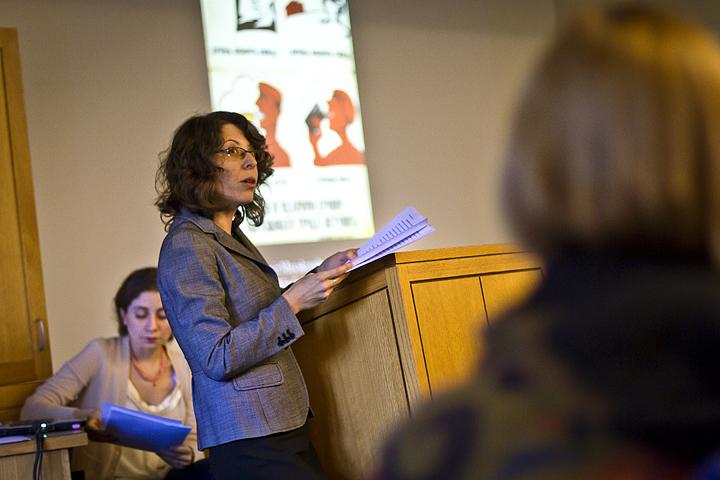Liliana Milkova and Masha Kowell, the curators of “Laughing Matters: Soviet Propaganda in Khrushchev’s Thaw” presented on the goals behind the exhibition in ARH on Thursday. The eighteen posters in the exhibition come from a period of post-Stalinist liberation during Nikita Khrushchev’s ascendency, 1956-1964 and were contributed by Aimée Brown Price and Monroe E. Price as part of the Soviet collection in the Burling Library.Milkova and Kowell’s wanted to reveal a little-known type of Soviet propaganda.“When the American population thinks of the propaganda of the Soviet Union, they think of it as monolithic, romanticizing, dictatorial, grandiose and bombastic rhetoric,” Kowell said. The pieces show a different, softer side of propaganda created during a specific era.

“These posters reveal Khrushchev propaganda as very human, playful and approachable,” Milkova said.
The propaganda that the curators believed Americans are most familiar with focuses on the repetitive, iconographic smiles and depictions of the perfect Soviet body signifying the vigor and prowess of the regime. Contrastingly, the artists and poets who created the posters seen in the exhibition concentrated on a deep satire of the seeming perfection of the Soviet Union.
The curators explained that the main group behind these works was the “Agitplakat: the Laughing Corpus,” Milkova and Kowell first discussed “Rosta Window,” (1920), by Valdimir Mayakovsky, a piece which they said showed an intense critique of the government.
The other work was by Nikolai Denisovskii (1901-1981) and Vasilii Fomichev (1908-1991). These artists envisioned their work as a gateway to unleash criticisms of the governmental structure and as critical laughter at the regime. The lecture divided the works by category.
The first group was “The Bloated Body of Bureaucracy,” for which they showed one of Fomichev’s pieces. The subject of this work is the failure of Russian bureaucracies and the laziness of the bureaucrats, as well as the marginalization of Soviet citizens—depicted by transparent people at the bottom of the poster.
The second group was “The Crumbling Body of the System,” which represented the thoughtless manner of the Honor Board.
The third group was “Dismembered Body,” in which the posters focused on the strong monitoring of Soviet people.
Lastly, “Punctured Body” revealed the flaws of the physical and moral standards in Soviet culture. For this the curators showed “The Outpouring of Consequences,” which revealed a man in a drunken heap, with green liquid escaping from a bottle of alcohol—a commentary on the issue of alcoholism.
Milkova and Kowell left the audience with the final message that these posters were meant to allow people to laugh at the standards of Soviet society, though they pointed out that there was a clear distinction between the lived reality and the posters’ reality. Finally, the curators said the posters should be appreciated not simply for their messages but their artwork as well.
The exhibition will be displayed in the basement of Burling Library until Nov. 19 and there will be a guided walk-through today, Friday, Oct. 29 at 4:15 p.m.


















































